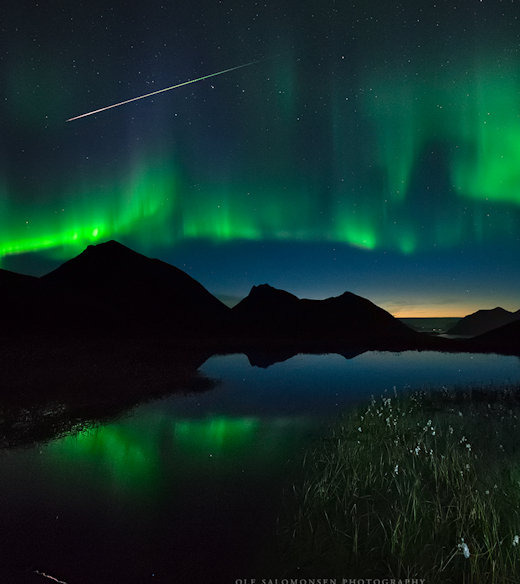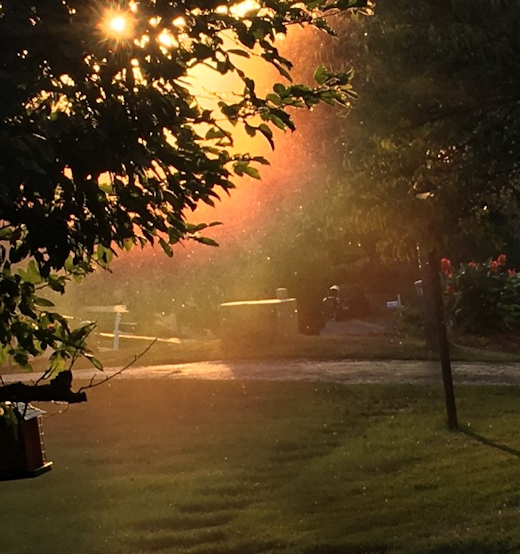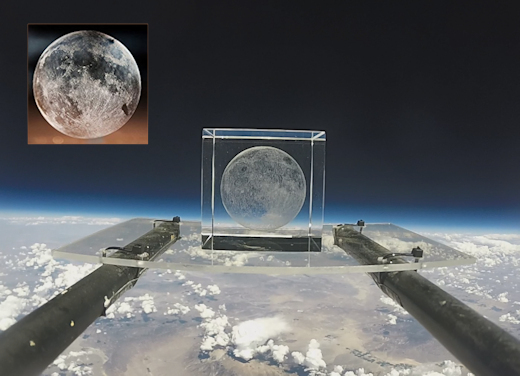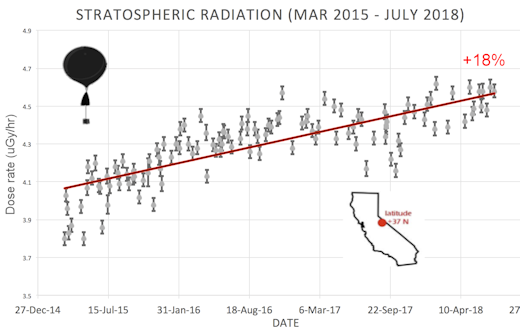Lights Over Lapland has a brand-new website full of exciting adventures in Abisko National Park, Sweden! Take a look at our aurora activities and book your once-in-a-lifetime trip with us today! | | | A HOLE IN THE SUN'S ATMOSPHERE: A canyon-shaped hole in the sun's atmosphere is facing Earth and spewing solar wind in our direction. Estimated time of arrival: Sept. 11-12. Minor geomagnetic storms and Arctic auroras are possible when the gaseous material reaches our planet next week. Free: Aurora Alerts. AURORAS AND A FIREBALL: As autumn darkness falls around the Arctic Circle, long-absent wonders are returning to the night sky. Yesterday in Tromsø, Norway, photographer Ole C. Salomonsen witnessed two of them--auroras and a fireball: 
"What an awesome display!" says Salomonsen. "I shouted out with joy after realizing I had captured this huge fireball mixed with auroras. I was also happy to have some colors from the sun left in the horizon to make the image complete." The fireball was a random meteoroid scooped up by Earth's atmosphere just as Salomonsen opened the shutter of his camera. The auroras appeared thanks to a CIR (co-rotating interaction region) that hit Earth a few hours earlier. CIRs are shock-like transition zones in the solar wind separating slow- and fast-moving gas. They often contain strong magnetic fields that do a good job sparking auroras. The two events combined for a truly lucky shot. Realtime Aurora Photo Gallery FUNGI CORONA: How do you make colorful rings around the sun? All it takes is a lawnmower and a mushroom. "On Sept. 5th, I was was cutting the grass and accidentally mowed over a puffball mushroom," reports Randy Hollaway of Pittsburgh, PA. "A huge cloud of fungi spores filled the air, creating a beautiful corona." 
Many of us have seen coronas. They appear when sunbeams hit small particles in the air, scattering and diffracting the light into colorful rings. Tiny droplets of water in clouds make most coronas. Pollen from flowers and trees can do it too. This may be the first recorded case of a fungi corona.
Take a closer look at Hollaway's photo. Individual spores may be seen glinting in the sunlight. Never has a lawn-mowed mushroom looked so good.
Realtime Space Weather Photo Gallery LASER-ETCHED MOON CUBE: On August 16, 2018, the students of Earth to Sky Calculus launched a cosmic ray balloon to the stratosphere. This unique laser-etched Moon cube went along for the ride, ascending to an altitude of 101,140 feet: 
You can have it for $149.95. The students are selling these cubes as a fund-raiser for their cosmic ray ballooning program. It's an authentic representation of the Moon, with all of the craters, mountains and lava plains accurately portrayed. Each Moon-cube comes with a unique gift card showing the item floating at the top of Earth's atmosphere. The interior of the card tells the story of the flight and confirms that this gift has been to the edge of space and back again. Far Out Gifts: Earth to Sky Store
All sales support hands-on STEM education
Every night, a network of NASA all-sky cameras scans the skies above the United States for meteoritic fireballs. Automated software maintained by NASA's Meteoroid Environment Office calculates their orbits, velocity, penetration depth in Earth's atmosphere and many other characteristics. Daily results are presented here on Spaceweather.com. On Sep. 8, 2018, the network reported 43 fireballs.
(37 sporadics, 6 September epsilon Perseids)  In this diagram of the inner solar system, all of the fireball orbits intersect at a single point--Earth. The orbits are color-coded by velocity, from slow (red) to fast (blue). [Larger image] [movies] Potentially Hazardous Asteroids ( PHAs) are space rocks larger than approximately 100m that can come closer to Earth than 0.05 AU. None of the known PHAs is on a collision course with our planet, although astronomers are finding new ones all the time. On September 8, 2018 there were 1923 potentially hazardous asteroids.
 | Recent & Upcoming Earth-asteroid encounters: | Asteroid | Date(UT) | Miss Distance | Velocity (km/s) | Diameter (m) | | 2018 RN | 2018-Sep-03 | 12.5 LD | 9.8 | 62 | | 2015 FP118 | 2018-Sep-03 | 12.3 LD | 9.8 | 490 | | 2018 QA | 2018-Sep-03 | 17.5 LD | 20.4 | 73 | | 2018 RR1 | 2018-Sep-03 | 0.9 LD | 4.6 | 4 | | 2018 RO1 | 2018-Sep-04 | 4.3 LD | 11.1 | 15 | | 2018 RO | 2018-Sep-05 | 5.8 LD | 6.4 | 23 | | 2018 RP | 2018-Sep-05 | 3.8 LD | 14.2 | 21 | | 2018 RS | 2018-Sep-05 | 0.3 LD | 17.1 | 5 | | 2018 RR | 2018-Sep-06 | 2 LD | 9 | 11 | | 2018 RQ | 2018-Sep-07 | 12.5 LD | 13.3 | 40 | | 2018 RF | 2018-Sep-08 | 11.8 LD | 13.3 | 44 | | 2018 RD1 | 2018-Sep-08 | 13.5 LD | 10 | 50 | | 2018 RW | 2018-Sep-08 | 0.4 LD | 6.3 | 3 | | 2018 RC | 2018-Sep-09 | 0.6 LD | 5.3 | 41 | | 2018 RE1 | 2018-Sep-10 | 11.1 LD | 26 | 44 | | 2018 RA1 | 2018-Sep-10 | 2.4 LD | 10.1 | 18 | | 2018 QU1 | 2018-Sep-11 | 10.9 LD | 12.5 | 102 | | 2018 RB1 | 2018-Sep-11 | 2.5 LD | 8.1 | 10 | | 2018 RC1 | 2018-Sep-15 | 16.7 LD | 2.2 | 20 | | 2017 SL16 | 2018-Sep-20 | 8.5 LD | 6.4 | 25 | | 2018 RQ1 | 2018-Sep-24 | 4.1 LD | 3.1 | 52 | | 2018 EB | 2018-Oct-07 | 15.5 LD | 15.1 | 155 | | 2014 US7 | 2018-Oct-17 | 3.2 LD | 8.7 | 19 | | 2013 UG1 | 2018-Oct-18 | 10.4 LD | 13.4 | 123 | | 2016 GC221 | 2018-Oct-18 | 8.7 LD | 14.4 | 39 | | 475534 | 2018-Oct-29 | 7.5 LD | 18.1 | 204 | | 2002 VE68 | 2018-Nov-04 | 14.7 LD | 8.6 | 282 | Notes: LD means "Lunar Distance." 1 LD = 384,401 km, the distance between Earth and the Moon. 1 LD also equals 0.00256 AU. MAG is the visual magnitude of the asteroid on the date of closest approach. | | Cosmic Rays in the Atmosphere | SPACE WEATHER BALLOON DATA: Approximately once a week, Spaceweather.com and the students of Earth to Sky Calculus fly space weather balloons to the stratosphere over California. These balloons are equipped with radiation sensors that detect cosmic rays, a surprisingly "down to Earth" form of space weather. Cosmic rays can seed clouds, trigger lightning, and penetrate commercial airplanes. Furthermore, there are studies ( #1, #2, #3, #4) linking cosmic rays with cardiac arrhythmias and sudden cardiac death in the general population. Our latest measurements show that cosmic rays are intensifying, with an increase of more than 18% since 2015: 
The data points in the graph above correspond to the peak of the Reneger-Pfotzer maximum, which lies about 67,000 feet above central California. When cosmic rays crash into Earth's atmosphere, they produce a spray of secondary particles that is most intense at the entrance to the stratosphere. Physicists Eric Reneger and Georg Pfotzer discovered the maximum using balloons in the 1930s and it is what we are measuring today. En route to the stratosphere, our sensors also pass through aviation altitudes: 
In this plot, dose rates are expessed as multiples of sea level. For instance, we see that boarding a plane that flies at 25,000 feet exposes passengers to dose rates ~10x higher than sea level. At 40,000 feet, the multiplier is closer to 50x. The radiation sensors onboard our helium balloons detect X-rays and gamma-rays in the energy range 10 keV to 20 MeV. These energies span the range of medical X-ray machines and airport security scanners. Why are cosmic rays intensifying? The main reason is the sun. Solar storm clouds such as coronal mass ejections (CMEs) sweep aside cosmic rays when they pass by Earth. During Solar Maximum, CMEs are abundant and cosmic rays are held at bay. Now, however, the solar cycle is swinging toward Solar Minimum, allowing cosmic rays to return. Another reason could be the weakening of Earth's magnetic field, which helps protect us from deep-space radiation. | | The official U.S. government space weather bureau | | | The first place to look for information about sundogs, pillars, rainbows and related phenomena. | | | Researchers call it a "Hubble for the sun." SDO is the most advanced solar observatory ever. | | | 3D views of the sun from NASA's Solar and Terrestrial Relations Observatory | | | Realtime and archival images of the Sun from SOHO. | | | from the NOAA Space Environment Center | | | fun to read, but should be taken with a grain of salt! Forecasts looking ahead more than a few days are often wrong. | | | from the NOAA Space Environment Center | | | the underlying science of space weather |  | If you are a Youtuber and want to buy real Youtube views than try out Buyrealsocial.com for the best results possible! |  | To find reviews of new online casino sites in the UK try The Casino DB where there are hundreds of online casino reviews complete with bonuses and ratings. | | | These links help Spaceweather.com stay online. Thank you to our supporters! | | | | | | | | | 
